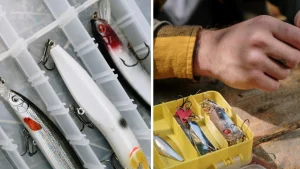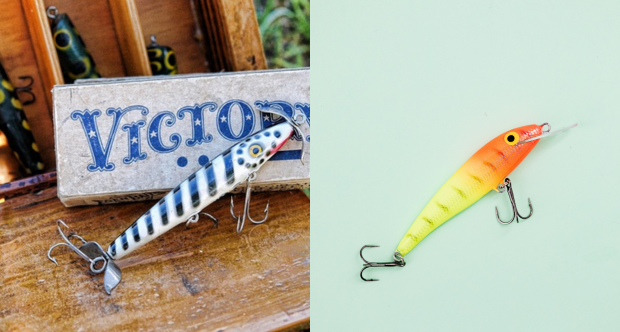If you are a fan of fishing, then you may want to know the similarities and differences between crankbait vs jerk bait. This article is for those who are curious about this topic and the most productive bait you can use when fishing.
The types of equipment used in fishing have evolved over the years. Modern types of equipment have become highly effective. When it comes to fishing, crankbait and jerk bait are the most popular bait among people. There are similarities and differences as well as pros and cons unique to each sort. So let’s find out all the information on crankbaits and jerk bait.

What is Crankbait?
The crankbaits are used to catch fish at a specific depth, consisting of a plastic lip that dives underwater. The plastic lip’s length and angle regulate the length and depth that the bait can reach underwater. These baits have a few variations. Mainly they can be categorized into three categories: Square bills, Round bills, and Lipless crankbaits.
You can maximize the coverage by placing crankbaits in a large water area, and also they are specially used for fishing large-mouth bass. Normally you can find these baits in the market in different colors, shapes, and sizes. You can always choose the bait according to your preference.
What is jerk bait?
Some other names are called jerk bait, such as slash bait or rip bait. These types of bait portray injured fish which has been given the name ‘jerk’ bait. These baits do not move independently; the fisherman will have to move under the water. These movements will get the attention of the fish nearby.
The most popular jerk bait variations are suspending jerk baits, floating jerk baits, and sinking jerk baits. You can use these baits for fishing in medium or shallow depths, even though it is said that these baits are best for clear and shallow water.

What are Crank baits good for?
It is known that crankbaits are best for fishing large-mouth bass. These baits allow you to search for a wide area of water. Typically, these baits are used in warm temperatures where the fish tend to chase the bait. One of the key elements in fishing is the depth of the water. If you are fishing under 1 to 12 feet, crankbaits are not the best option.
The water depth must be between 12 to 20 feet to get the maximum result from using the crankbait. It will allow you to fish effectively and accurately in deeper diving. Also, these baits will be most effective in dirtier or discolored water than in clean water. This happens because of the vibration and the noise.
What are jerk baits good for?
These baits are also used for fishing various predatory fish species, mostly under cold and clear waters. Moreover, jerk baits are best for fishing if the water depth is up to 1 to 12 feet. The main goal of the jerk bait is to perform as a minnow or baitfish dying. This is what makes the other predatory fish strike. The technique of this bait is almost similar despite the type of bait you use.
The technique is typically a few movements and then a pause for a few seconds. This particular movement will get the fish’s attention and make them go for it. Keep in mind not to hold the pause for a longer period; you will not get the fish’s attention. The jerk baits can cause the reaction to bite even if it is not in feeding mode. As the jerk bait is designed for diving in wide depths of water. These baits can adapt to any temperature, warm or cold.
How fast do you pull crankbaits?
Once all the equipment, such as rods, reels, crankbaits, rod holders, and a place to do fishing, are ready, you must devise a trolling plan. Here we will let you know how fast you can pull crankbaits and give tips on how the process works properly.
Start by choosing the path; also, you should consider the direction of the wind and will be able to turn around if needed. Depending on the wind and the waves in the water, you can put the crankbait under 12 to 16 feet if you throw at a speed of 1.5 mph.
When pulling the crankbait, you must have a speed of 1.5 mph to 1.7mph.
Crankbait vs jerk bait
Both baits, crankbait and jerk bait, are perfect for catching bass, walleye, lake trout, catfish, and many more predatory species. But there are some considerable differences in both of these baits. In addition, they come in different shapes and sizes which you can choose according to your liking. These baits are diving baits, but the shape, action, and depth they can dive in make them different. Here we will explain the differences and the techniques of using crankbait and jerk bait.
Body shape
Crankbaits have wider and longer bodies than jerk bait, where they have a long and narrow body shape. There are some reasons for the variations in body shape. One factor in different sizes is that the narrow bodies are subtler when the water temperature is cold and have less water displacement.
Water depths
The crankbait can sink into various depths because of the shape of the body; wider and shorter. The size of the bill also will determine the depth the bait can dive. Crankbaits are mostly used in lakes and deep rivers, as they can dive more than 20 feet.
But the jerk bait performs completely differently. The bill size is far smaller compared to crankbaits. They perform well under 1 to 12 feet in depth and are mostly used for fishing in creeks and ponds.
Water clarity
For the jerk bait, the clarity of the water must be clearer as it is designed more on the colors. So the jerk bait is less effective in dirty or discolored water as it is hard for the fish to track it down.
But for the crankbait, it is the other way around. These baits are more effective in dirty or discolored water as it is designed to give action and vibration. And if the water is very muddy, you can throw a crankbait with a rattle on it, giving more sound and vibration.
You May Also Like:

